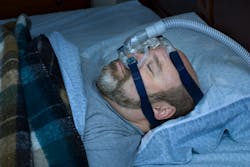An estimated 70 million Americans have sleeping disorders. And while roughly 80 sleep disorders have been identified, obstructive sleep apnea (OSA) is one of the most prevalent and undiagnosed sleep disorders impacting the transportation industry, according to Rodolfo Giacoman, fatigue management program specialist at the Commercial Vehicle Safety Alliance (CVSA).
Bob Stanton, a former over-the-road truck driver of 20 years, knows the effects of OSA all too well. Stanton drove long-haul for two years untreated before his diagnosis.
“I honestly thought the only way to drive the night shift was drive a half hour, take a power nap, drive a half hour, take a power nap,” Stanton said during a recent CVSA and North American Fatigue Management Program webinar providing guidance on how fleets can develop and implement a sleep disorder management program (SDMP).
“Luckily, I got tested and treated before carrier-based programs were the norm,” Stanton added. “A lot of the problems I encountered early in my sleep apnea journey have been solved both with technology and carrier-based programs.”
Stanton urged fleet managers to recognize that 26% to 30% of commercial drivers on the road today have OSA, yet only 5% to 15% of them are undergoing effective treatment for it.
“Helping drivers treat their sleep apnea will help them improve their quality of life, decrease their accident rates, you’re probably going to retain them longer, and you’ll reduce your health-care costs,” Stanton noted.
See also: CVSA now home to driver fatigue program
In addition to OSA, some of the most common sleep disorders plaguing Americans today include insomnia, narcolepsy, restless leg syndrome, sleep walking, and abnormal circadian rhythms. Sleep disorder symptoms include excessive daytime sleepiness (EDS), extremes in the ability to go to sleep, and loud irregular snoring with gasping.
For OSA in particular, breathing stops repeatedly during sleep and lasts more than 5 seconds per hour due to closures of the upper airway. Symptoms of OSA are difficult to self-detect and are often mistaken for other conditions, Giacoman advised.
Health implications of OSA include non-alcoholic fatty liver disease, diabetes, cardiovascular disease, hypertension, lipid abnormalities, polycystic ovarian cancer, dementia, diminished quality of life, and clinical depression.
For professional truck drivers, these health and safety implications can be severe. EDS can cause drivers to fall asleep at the wheel, increase the decline in their cognitive functionality, impair driving performance, decrease their reaction time, and possibly lead to more costly and fatal crashes.
Adopting a sleep disorder program: The ROI factor
In 2006, Schneider National implemented an OSA program requiring all new company drivers to be screened for sleep apnea and for those at risk to go through sleep apnea testing. As part of Schneider’s employee health program, the carrier covers the cost of diagnosed drivers’ continuous positive airway pressure (CPAP) machines and supplies.
During a separate CVSA discussion with Giacoman, Schneider pointed out the company experienced an average savings of $550 per driver per month in health-related costs for drivers treated via CPAP.
The carrier also saw a 73% reduction in preventable crashes among drivers treated for OSA. In addition, the retention rate of treated OSA drivers was 2.3 times greater than for all company drivers.
See also: Painting a fleet safety picture to reduce habitual speeding, driver fatigue
Aside from those specific returns on investment, a properly developed and implemented SDMP could help commercial carriers avoid massive lawsuits.
Litigation claims in past OSA- and fatigue-related truck crashes have found that carriers should have known if their drivers had a sleep apnea disorder based on evidence from driver medical examination reports, carrier health records, and reports of witnessed EDS in the workplace.In addition, carriers were more likely to be found negligent if they did not monitor and follow up with a driver with OSA, or if their fatigue management programs (FMP) were inappropriate, incomplete, or not implemented.
“I have been an expert witness in some of these nuclear verdicts and some not,” said Adrian Knight, president and CEO of SleepSafe Drivers. “The carrier can do several things. One is not do anything, and that’s what we mostly see in these types of verdicts—that the carrier has not done anything, or that the driver has falsified the information and has not worn the CPAP device or told the medical examiner that he or she has been diagnosed with sleep apnea. That is all discoverable.”
“Once upon a time we could claim ignorance is bliss; that’s not the reality anymore,” added John Hickok, iSleep CEO and founder. “With modern technology, we can monitor wireless compliance. We can’t walk into a courtroom anymore and say, ‘I didn’t know.’ If you don’t know it’s because you chose not to know, and the court is just not accepting that these days.”
Fatigue management technologies
In addition to SDMPs, carriers can also implement programs and adopt fatigue management technologies (FMT) throughout their fleet.
In a separate NAFMP presentation earlier this year, Giacoman pointed out that driver education and training is the most important component when implementing a fatigue management program. For commercial motor vehicle drivers, managing fatigue mainly means changing behavior.
Ultimately, an FMP attempts to realign corporate culture to support fatigue management, address dispatching practices that hinder drivers from obtaining adequate sleep, provide training and education to drivers to improve sleep habits, and introduce drivers to a sleep disorder screening and treatment program, according to NAFMP’s implementation manual.
In- and out-of-vehicle technologies could also be useful. The first line of defense against driver fatigue could be a wearable that detects and measures activity when a driver is active or resting.
Furthermore, in-vehicle technologies, like video, are designed to monitor drivers and the roadway. Pre-drive monitoring, for example, measures driver physiology and psychomotor skills. Real-time driver monitoring in the vehicle pinpoints last stop-gap countermeasures, driver physiological measures and psychomotor skills, and vehicle kinematics and driver input.
In-vehicle FMTs include eye measurements, lane monitoring, steering input, reaction time, and actigraphy, which uses predictive sleep algorithms to determine drivers’ sleep quantity and quality, along with rest and activity patterns.
Then, there are back-office level FMTs, such as driver scheduling software, freight planning software, and fit-for-duty testing that can be used before a driver begins their shift.
“Driver-level FMTs are the final line of defense against driver fatigue,” Giacoman advised. “They identify and alert the driver of impending fatigue, performance degradation, and driver errors.”





